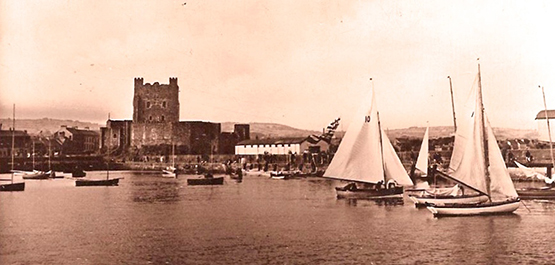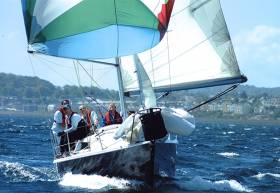Displaying items by tag: Impala 28
Big Interest in East Down Yacht Club's 11-boat Impala 28 Fleet
From two Impalas in the early days at East Down Yacht Club to 11 now is very satisfying progress at the club situated on the western shore of Strangford Lough. This would be the envy of many of the local sailing fraternity in Northern Ireland and indeed farther afield.
There are very few one-design cruiser fleets still racing competitively in Strangford Lough, or in Belfast Lough, so the EDYC burgeoning fleet of Impalas is attracting considerable interest.
 Impala 28s racing as One Designs at East Down
Impala 28s racing as One Designs at East Down
But it has been the continuing addition of more of this popular 28ft design that has had a knock-on effect and now there are eleven. And indeed, another has arrived in the Lough recently, which I understand will be at nearby Strangford Lough Yacht Club – Mike Heath’s Jimmy Cricket is ready to race.
 Impala Jimmy Cricket is new to Strangford Lough
Impala Jimmy Cricket is new to Strangford Lough
At the inaugural Impala owners’ meeting in December 2020, it was decided that the class should develop towards a proper One Design Fleet with all boats complying strictly with class rules.
The hope now is to keep growing the fleet and to attract new club members interested in crewing or owning an Impala 28. They will be out in force at this weekend’s Spring Series two-day Open event at Quoile Yacht Club in the southwestern corner of the Lough.
Impala 28 OOD 'Wild Mustard' For Sale at €14,950
The Impala 28 OOD Wild Mustard is for sale.
Wild Mustard is a 1982 version of this successful IRC design, having had a "small fortune" spent on her, according to owner Dave Cullen of Howth.
The most recent additions to her inventory are a new UK Main and No 1 plus North 0.5oz kite – all used only four times.
She was converted from outboard to diesel with a refurbished engine fitted in 2018 including a new shaft, folding prop, electrics, etc. (cost €9k).
Cullen says "this boat is an IRC bandit and has won everything it has entered at some stage including Class 3 National several times". Her current rating is 0.885.
Full details of the boat are listed on Afloat boats for sale here and she is priced at €14,950
If ever you call by Baltimore in a cruising boat at the height of the summer, you’ll find you’re rubbing shoulders with sailing families from all over Ireland writes W M Nixon. This is despite the popular view that the thriving Baltimore Sailing Club is a sort of Royal Cork Yacht Club West. For sure, there are plenty of Crosshaven folk with a second base in West Cork. But the appeal of Baltimore is such that in the best of the sailing season, the thronged waterfront is filled with summer-resident amateur sailors at every level of dedication from all corners of Ireland.
Typical of them is the extended Kennedy family from Belfast. Originally, the Kennedy brothers Hugh, Joe and Frank learned their sailing at Whitehead at the northeast corner of Belfast Lough, as their mother had family connections to the peninsula of Islandmagee to the east of Larne Lough, and Whitehead is the gateway to Islandmagee.
My own family got to know the Kennedys when the three brothers bought the Belfast Lough 18ft Waverley Class Rowena from my father in 1948, when he in turn was moving into partnership with my uncle in one of the then-new Belfast Lough Glen Class 25-footers.
Although the Waverleys had originated in Whitehead where they were created by the amateur designer John Wylie in 1902, a strong branch of the class had soon developed across Belfast Lough in Ballyholme Bay, and it was from here that our family’s Rowena – Waverley No 1 - was sold to the three brothers who went on to enhance her already-established reputation as one of the fastest boats in the class.
In time the Kennedy sailing reputation spread into other boat types, with Hugh – who became a successful barrister – spreading his wings in a big way in dinghies, while Joe – who had become a surgeon - was more into keelboats. Our families were linked in sailing, as Joe crewed for one of my brothers on a cruise to the Faroes in a 37-footer, while another brother crewed for Hugh in dinghies right up to the top level in 505s.
It seems to have been the dinghy racing which began the Kennedy link to Baltimore. Successful Dinghy Weeks at the West Cork venue in 1960 and 1964 created friendships in a growing matrix which eventually blossomed into marriage into the Cork sailing community. So though the Kennedys were very much Belfast-based for ten months of the year, for at least six weeks of each summer they were paying a central role in the Baltimore sailing
scene.
That Baltimore scene had become very active by the late 1970s, and when the David Thomas-designed Impala 28 was unveiled in 1977 as the smallest of a trio of officially-sanctioned Offshore One Designs, the brains of Baltimore got to thinking that this would be an ideal boat for their summer sailing needs at the heart of one of Europe’s best sailing and cruising areas.
One of those to whom this appealed was Joe Kennedy, and when his new Impala 28 appeared in 1980, naturally she was called Rowena. In Baltimore she became part of a local phenomenon, as the summer Impala fleet there – though based on a solid nucleus of only four boats of which Rowena was one – could swell rapidly to fleets of 15 and more when they staged popular events which became known as the Impala 28 Europeans.
For some years now, Rowena has been in the ownership of Andrew Kennedy, a surgeon like his late father Joe. But after this rare example of a boat being with one family for more than a quarter century, family pressures mean he simply has to upsize, and Rowena had just been freshly-commissioned at Bangor Marina, and is for sale at the very reasonable price of €5,700.
Admittedly you are getting a very basic Impala 28 just as David Thomas envisaged her, albeit a boat in good order. David Thomas was obsessed with saving weight, thus though the Impala 28 is quite voluminous with plenty of room for an inboard auxiliary, he insisted that she be fitted only with an outboard, and in line with this, Rowena comes with a very modest Yamaha 6hp four-stroke.
However, many early owners became exasperated by the hassle of an outboard and loathed the unsightly way it hangs off the transom, so they soon started installing the new small inboard diesels which were coming onto the market at the time. The result was not only neat and reliable, but despite having to trail a feathering propeller, it was found that the extra weight low down in an optimal position within that roomy hull might actually have improved windward performance in a breeze.
It’s something to think about if you’re looking at Rowena. But happily it’s not a priority – she’s ready to go. She comes complete with a two-burner gimballed stove in the galley, she has been recently re-wired, and her equipment includes ICOM CHF, new NASA Depth and Speed, and a Mark 2 rudder for those who might be interested in the Impala’s still very viable racing possibilities.
As to the original Rowena, eventually she moved back into Ballyholme ownership, and this being in the days before Bangor Marina had been created, in one of those rare but vicious northeasterly gales which sweep the anchorage in Ballyholme Bay from time to time, the first and fairest of the Waverleys was sadly lost. However, it’s rumoured that her ballast keel is still around, in a hidden corner of Ballyholme YC boatpark. Now there’s a real opportunity for someone who likes re-creating classic yachts…….

Waverley Class No 1 Rowena (at right) in Carrickfergus Harbour during a Carrickfergus SC regatta around 1950, when she was owned by the Kennedy brothers of Whitehead. The Carrick club – which this year is celebrating its 150th anniversary – was housed in those days in the white boathouse at mid-photo.
The full advert giving a very complete inventory is on the Afloat boats for sale site here
























































